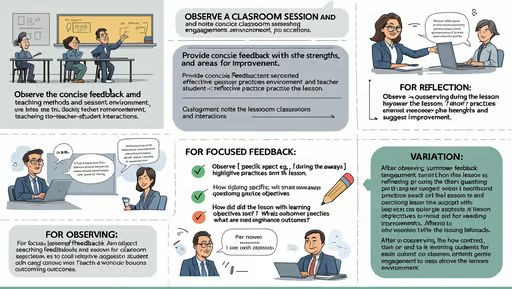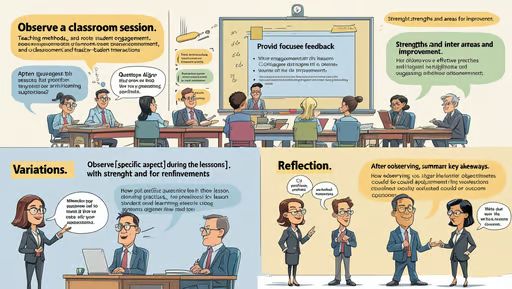Introduction:
Classroom observation is a pivotal tool in the realm of education, serving as a catalyst for continuous improvement and fostering an environment conducive to effective teaching and learning. This practice involves the systematic and purposeful examination of a teacher’s instructional methods, classroom management techniques, and student engagement strategies. Through careful observation and thoughtful analysis, educators can identify areas of strength and areas for growth, ultimately contributing to the enhancement of educational excellence.
The Importance of Classroom Observation:
- Classroom observation plays a crucial role in the professional development of teachers and the overall improvement of educational practices. By providing an objective and external perspective, observations offer insights into the dynamics of the learning environment, allowing educators to reflect on their teaching strategies and make informed adjustments.
- Observations facilitate a deeper understanding of individual teaching styles, enabling teachers to tailor their approaches to better meet the diverse needs of students. This personalized adaptation contributes to a more inclusive and effective learning experience.
- Additionally, It serves as a valuable tool for assessing the implementation of educational policies and curriculum standards. It ensures alignment between intended outcomes and actual practices, fostering accountability and promoting continuous refinement of teaching methodologies.

The Process of Classroom Observation:
- Effective classroom observation involves a systematic and collaborative approach. Typically, an observer, often an instructional leader or a peer, spends time in a classroom, attentively watching and documenting various aspects of the teaching and learning process. This process may include recording instructional techniques, student interactions, classroom management strategies, and the overall learning atmosphere.
- Following the observation, a constructive feedback session ensues, during which the observer and the teacher engage in a collaborative discussion. This dialogue aims to highlight strengths, address areas for improvement, and establish actionable goals for professional growth.
Benefits for Teachers:
- This provides teachers with an opportunity for self-reflection and continuous improvement. By receiving feedback from an external perspective, educators can gain valuable insights into their teaching practices and make informed decisions to enhance their instructional methods.
- Furthermore, regular classroom observations create a culture of professional development within the educational community. Teachers can share effective strategies, learn from one another, and collectively contribute to the improvement of teaching practices.

Benefits for Students:
- Ultimately, the primary beneficiaries of effective classroom observation are the students. As teachers refine their instructional techniques, classroom management skills, and overall pedagogical approach, students experience a more engaging and supportive learning environment.
- By addressing the diverse needs of learners, teachers can adapt their methods to cater to various learning styles and abilities. This personalized approach fosters a positive educational experience, ultimately contributing to improved student outcomes.
Conclusion:
In conclusion, classroom observation is a cornerstone of educational improvement, promoting a culture of continuous learning and professional development. Through this process, teachers can refine their instructional practices, enhance classroom management, and create a more inclusive and effective learning environment. As the education landscape continues to evolve, the role of classroom observation remains integral to the pursuit of educational excellence.

I don’t think the title of your article matches the content lol. Just kidding, mainly because I had some doubts after reading the article.
Thank you for your sharing. I am worried that I lack creative ideas. It is your article that makes me full of hope. Thank you. But, I have a question, can you help me?
Your point of view caught my eye and was very interesting. Thanks. I have a question for you. https://www.binance.com/pt-PT/join?ref=DB40ITMB
Thank you for your sharing. I am worried that I lack creative ideas. It is your article that makes me full of hope. Thank you. But, I have a question, can you help me? https://accounts.binance.com/zh-TC/register?ref=VDVEQ78S
bg101s
Some really prime posts on this internet site, saved to favorites.
gee5m1
Nikmati Permainan Slot Gacor di sigmaslot dengan RTP Tinggi dan Jackpot Menggoda
Very nice post. I just stumbled upon your weblog and wanted to say that I’ve truly enjoyed browsing your blog posts. In any case I will be subscribing to your feed and I hope you write again very soon!
inevjd
tbyku6
Usually I don’t read post on blogs, but I wish to say that this write-up very forced me to try and do it! Your writing style has been surprised me. Thanks, quite nice article.
There is visibly a lot to realize about this. I believe you made certain nice points in features also.
Thank you for sharing superb informations. Your site is so cool. I am impressed by the details that you have on this website. It reveals how nicely you perceive this subject. Bookmarked this website page, will come back for more articles. You, my friend, ROCK! I found just the information I already searched everywhere and just couldn’t come across. What a great web site.
This is really interesting, You’re a very skilled blogger. I’ve joined your rss feed and look forward to seeking more of your excellent post. Also, I have shared your site in my social networks!
Whats up! I just wish to give a huge thumbs up for the nice data you might have right here on this post. I can be coming again to your blog for more soon.
Your article helped me a lot, is there any more related content? Thanks!
In the grand pattern of things you’ll receive an A+ just for effort and hard work. Where exactly you actually misplaced me personally ended up being in all the particulars. As it is said, details make or break the argument.. And that could not be more accurate here. Having said that, permit me inform you what exactly did do the job. Your authoring can be incredibly engaging and this is probably the reason why I am taking an effort to opine. I do not really make it a regular habit of doing that. Secondly, although I can certainly see the leaps in reason you make, I am definitely not sure of exactly how you seem to unite your details which in turn help to make the actual final result. For the moment I shall subscribe to your position but hope in the near future you actually connect your facts better.
I conceive you have mentioned some very interesting details , appreciate it for the post.
Your article helped me a lot, is there any more related content? Thanks!
Thank you for every one of your efforts on this blog. My aunt really likes making time for internet research and it is easy to see why. All of us hear all about the powerful method you produce simple items on this website and as well as inspire response from other people on that area then our girl is undoubtedly understanding a whole lot. Enjoy the rest of the year. You have been doing a tremendous job.
Hello! I’m at work surfing around your blog from my new iphone 3gs! Just wanted to say I love reading your blog and look forward to all your posts! Carry on the fantastic work!